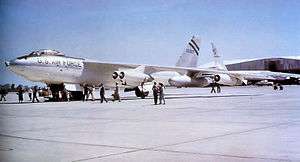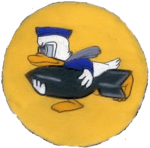442d Air Expeditionary Squadron
| 442d Air Expeditionary Squadron | |
|---|---|
 320th Bombardment Wing B-47 Stratojet[note 1] | |
| Active | 1942–1945; 1947–1949; 1952–1960 |
| Country |
|
| Branch |
|
| Role | Expeditionary Support |
| Part of | Air Combat Command |
| Engagements | Mediterranean Theater of Operations[1] |
| Decorations |
Distinguished Unit Citation French Croix de Guerre with Palm[1] |
| Insignia | |
| 442d Bombardment Squadron emblem (approved 10 August 1953)[2] |
 |
| 442d Bombardment Squadron emblem (World War II)[3] |
 |
The 442d Air Expeditionary Squadron is a provisional United States Air Force unit. Its last assigned in the regular Air Force was to the 320th Bombardment Wing at March Air Force Base, California, where it was inactivated on 15 September 1960.
The squadron was first activated during World War II as the 442d Bombardment Squadron. It served in combat in the Mediterranean Theater of Operations, where it earned two Distinguished Unit Citations and the French Croix de Guerre with Palm. After V-E Day, the squadron returned to the United States for inactivation.
Although briefly active in the reserve from 1947-1949, the squadron was primarily a Strategic Air Command bomber unit with Boeing B-47 Stratojets. The squadron was inactivated in 1960, in connection with the phasing out of the B-47.
History
World War II
Established in mid-1942 as a Martin B-26 Marauder medium bomber group. Trained under Third Air Force in Florida, deployed to England under the VIII Air Support Command, 3d Bombardment Wing.
Operated against targets on the continent during early fall of 1942; deployed to North Africa as part of Twelfth Air Force after Operation Torch landings in Algeria in November. Flew tactical bombing missions against Axis forces in North Africa until the end of the Tunisian Campaign in May 1943. Participated in the Sicilian and Italian Campaigns; liberation of Corsica and Sardinia and the Invasion of Southern France. Supported Allied ground forces in the Western Allied Invasion of Germany, spring 1945 and becoming part of the United States Air Forces in Europe Army of Occupation in Germany, fall 1945. Personnel demobilized in Germany and the squadron inactivated as a paper unit in December 1945.
Reserves
Reactivated in the reserves in 1947. Never manned or equipped.
Strategic Air Command operations
Reactivated in 1952 as a Boeing B-47 Stratojet squadron,. Initially equipped with prototypes of the Boeing RB-47B Stratojet (YRB-47) to perform long-range photo-reconnaissance with a flight of Boeing B-29 Superfortress bombers assigned. In November 1953 began to receive production B-47E medium bomber aircraft; prototype reconnaissance aircraft already received exchanged for medium bomber versions. Participated in SAC REFLEX deployments to Europe and North Africa throughout the 1950s. Inactivated in 1960 as part of the phaseout of the B-47, aircraft sent to storage at Davis-Monthan.
Lineage
- Constituted as the 442d Bombardment Squadron (Medium) on 19 June 1942
- Activated on 1 July 1942
- Redesignated 442d Bombardment Squadron, Medium on 9 October 1944
- Inactivated on 6 December 1945
- Redesignated 442d Bombardment Squadron, Light on 26 May 1947
- Activated in the reserve on 9 July 1947
- Inactivated on 27 June 1949
- Redesignated 442d Bombardment Squadron, Medium and activated on 1 December 1952
- Discontinued on 15 September 1960
- Redesignated 442d Air Expeditionary Squadron and converted to provisional status on 13 May 2011[1]
Assignments
- 320th Bombardment Group, 1 July 1942 – 4 December 1945
- 320th Bombardment Group, 9 July 1947 – 27 June 1949
- 320th Bombardment Wing, 1 December 1952 – 15 September 1960
- Air Combat Command to activate or inactivate as needed after 13 May 2011[1]
Stations
|
|
Aircraft
- Martin B-26 Marauder, 1942–1945
- Boeing B-29 Superfortress, 1952–1953
- Boeing YRB-47B Stratojet, 1953
- Boeing B-47 Stratojet, 1953–1960[1]
References
- Notes
- ↑ Aircraft is Boeing B-47B-50-BW Stratojet serial 51-2307
- Citations
Bibliography
![]()
- Anderson, Capt. Barry (1985). Army Air Forces Stations: A Guide to the Stations Where U.S. Army Air Forces Personnel Served in the United Kingdom During World War II (PDF). Maxwell AFB, AL yes: Research Division, USAF Historical Research Center. Archived from the original (PDF) on 23 January 2016. Retrieved 28 June 2017.
- Johnson, 1st Lt. David C. (1988). U.S. Army Air Forces Continental Airfields (ETO) D-Day to V-E Day (PDF). Maxwell AFB, AL: Research Division, USAF Historical Research Center. Archived from the original (PDF) on 29 September 2015. Retrieved 26 June 2017.
- Maurer, Maurer, ed. (1983) [1961]. Air Force Combat Units of World War II (PDF) (reprint ed.). Washington, DC: Office of Air Force History. ISBN 0-912799-02-1. LCCN 61060979. Retrieved 17 December 2016.
- Maurer, Maurer, ed. (1982) [1969]. Combat Squadrons of the Air Force, World War II (PDF) (reprint ed.). Washington, DC: Office of Air Force History. ISBN 0-405-12194-6. LCCN 70605402. OCLC 72556. Retrieved 17 December 2016.
- Ravenstein, Charles A. (1984). Air Force Combat Wings, Lineage & Honors Histories 1947-1977 (PDF). Washington, DC: Office of Air Force History. ISBN 0-912799-12-9. Retrieved 17 December 2016.
- Watkins, Robert A. (2009). Insignia and Aircraft Markings of the U.S. Army Air Force In World War II. Volume IV, European-African-Middle Eastern Theater of Operations. Atglen,PA: Shiffer Publishing, Ltd. ISBN 978-0-7643-3401-6.